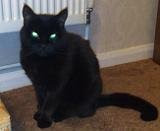Cats have become one of the world's most popular household pets, perfectly suited to our modern day lifestyle. They are beautiful, enigmatic and their independence makes them easy-to-care for. But where and when did the domestic cat originate?
It is approximately 4000 years since the first cats were domesticated. The Ancient Egyptians were the first to keep and use cats to control vermin and other rodent pests that infected their grain stock along the Nile. It was not long before the cat was revered as a hunter with laws protecting them. Soon the superiority of the cat brought eventual worship as gods and goddesses. Bastet - Daughter of the sun god Ra, is an ancient Egyptian goddess who was usually represented as the body of a woman and the head of a domesticated cat, and is still greatly revered by many today. To impose the sacred status of the domestic cat, ancient Egyptians imposed the death penalty for killing cats and cats were also mummified before being buried. During this time cats were ranked higher in Egyptian society than most humans.
This high ranking meant cats became such a high commodity for controlling vermin they were smuggled out of Egypt for trade. The population of the domestic cat grew as it slowly spread across Europe and other ancient civilisations. The domestic cat also spread from India to Japan and China, where it was first given as gifts to emperors.
Unfortunately this was about to change and mankind was soon to turn on the cat and associate it with what it believed to be evil, with two joining periods of persecution towards cats. During the Middle Ages cats were connected with witchcraft and devil worship, which continued into the 14th Century when cats were presumed responsible for the outbreak of the Bubonic Plague (The Black death). During the time of the plague many cats were killed. The Black Death devastated Europe from 1346 to 1349. This and other plagues were blamed on witchcraft, and the witch trials became intense at this time. Pope Innocent VIII issued a decree in 1484 denouncing all cats and anyone who owned one. He commanded that, "whenever a witch was burned, her cat must be burned with her". This left rodents who carried the plague, through fleas to increase, creating a devastating epidemic.
Once the cause of the outbreak was discovered, cats and their ability to destroy rodents were welcomed once again back into the home. Domestic cats today still take many characteristics from their wild ancestors. The impressive eyes, body shape, grooming habits are the same along with the ability to pounce into action at any given moment. When a cat is being aggressive they revert back to their ancestral wild role and may hiss, growl, swipe, arch their back, swing their tail or flatten their ears. If their aggression is confident it is likely their tail will be straight up with, pupils narrowed, perk their ears and even prance sideways to appear larger. Fearful cats especially indoor cats are likely to flee or freeze on the spot at a fearful situation.
Some legends and superstitions about cats still exist today. Because of their agile abilities it is said cats have nine lives. Another superstition states that a black cat crossing one's path brings bad luck, but in Great Britain black cats are thought to bring good luck. Or if a cat sleeps with it’s back to the fire very bad weather is on the way (references for superstitions came from my mother).
Today’s domestic cat is not simply noted for its fierce hunting skills and keeping out rodents. Today the elegant, graceful cat has become a popular house pet throughout the world. They are independent while loveable; mysterious yet mischievous. Cats are valued for their gentle, affectionate natures. A cat's loyalty is earned; they respond to loving owners with loyalty, affection, and respect.
Leonardo DaVinci summed it up best when he referred to the cat as "Nature's Masterpiece."
Reference:
http://google.nationalgeographic.com/
http://www.encyclopedia.com/
http://en.wikipedia.org/wiki/Cat
Monday, 16 June 2008
Subscribe to:
Comments (Atom)
